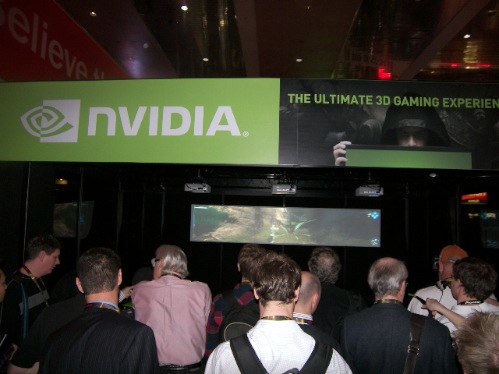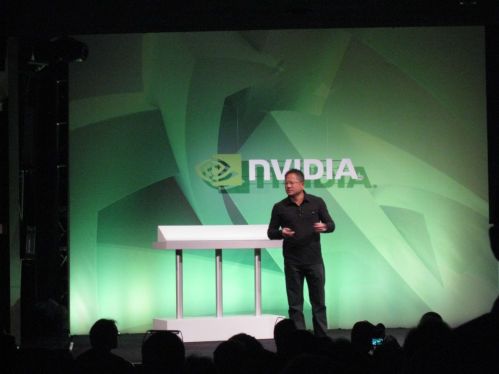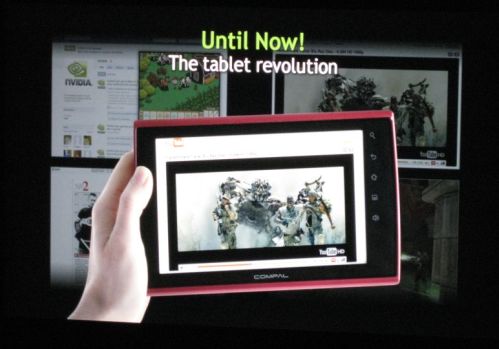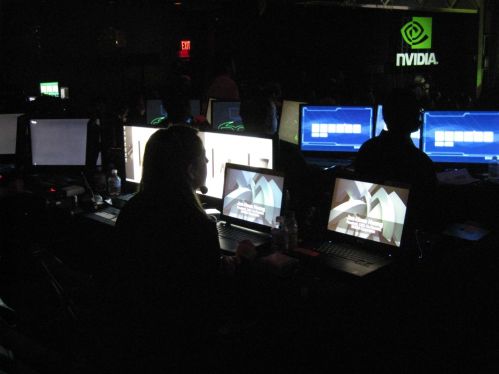It’s day one of CES and we have just survived through Nvidia’s annual CES press conference. This year’s event was held in the Hilton Hotel Showroom. Many familiar faces of journalists, analysts and industry affiliates filled the room eagerly awaiting Jen-Hsun’s voice for the first time in a new decade.

The keynote began with the beloved CEO walking on-stage and letting out a sigh of relief. “This is going to be an amazing year. Today I want to talk to you about three things – the PC revolution, the phone re-invented, and 3D Vision.” At this point, a slideshow played on the large screen highlighting all of Nvidia’s computational GPU achievements over the past four years since the emergence of DirectX 10 and CUDA.
"The PC Revolution – everybody who wants one, everybody who needs one, already has one. At this point, the PC is no longer your only computer. In fact, this is the beginning of a new era – not the PC era, but the era of personal computing with multiple devices of all kinds.” In a nutshell, this statement served as the precursor to a new concept in mobile scalability that the CEO wanted to explain next.
“The phone re-invented – people want to access the web from wherever they are, and that posed a difficult challenge to tackle. The main problem is that web content is high resolution, and it is often very difficult to scale to lower pixel resolutions found on mobile smartphones. There are over 25 billion web pages on the internet, most of them formatted at 1024x768. This makes it difficult to recode a webpage for mobile browsing.”

Basically, the iPhone doesn’t cut it for web content found on Facebook, YouTube, and a plethora of Web 2.0-based and Flash Player-based interactive sites. He points out the significance of YouTube having “over 31 billion videos viewed in November 2009” with “a great deal of users spending time viewing video content on the web.” All of this is great content for desktop users, but it is critically important to be able to go to any website and have interactive content scale properly.“
We need the portability and accessibility of a smart phone, but the full web compatibility of a PC. But this is a daunting challenge to achieve. The performance makes it heavy, hot and expensive. Mobility causes the devices to be smaller using smaller chips.”
Look and behold, the one device that will turn the tide of mobile computing and revolutionize the way we entertain ourselves on the go. Introducing the tablet revolution, allowing users to render web pages just like notebooks with discreet GPUs, but at a fraction of the power and with even more portability.

Nvidia’s solution is the new Tegra 2, which we wrote about in November and anticipated the launch at today’s keynote. The new SoC is indeed twice as powerful as the original with a dual-core ARM Cortex A9 CPU, eight independent processors nd a 500mW TDP.
Jen-Hsun held the new Tegra 2 SoC in his hand. “On the backide are the NAND-flash memory modules. The [Tegra] requires no power management, no fans, no heatpipes, no ventilation – just electicity. Turn it on, and it works. This tiny computer is going to change mobile form-factor design. The industrial design is going to become very clever. Tegra is the key missing ingredient that allows us to combine all the innovation that has happened up until now, so we can aneable this new experience to browse the full web anywhere.”
We are more than happy to report that the power efficiency benefits of this new design are exceptionally satisfying. Tegra 2 enables tablet devices to have up to 140 hours of music playback (over 200 CDs played continuously) and up to 16 hours of HD video playback on a single charge.
At this point, Mike Rayfield, General Manager of Tegra goes on stage to demonstrate the new SoC on several tablet devices. First up is a Foxconn tablet running a proprietary touch-navigation user interface. The smooth responsiveness of the UI was satisfactory to say the last. Next was a demonstration of e-reading capabilities. Finally, there was a demonstration of 1080p Full-HD video content on the new Tegra 2 in comparison to an Intel Atom netbook. As expected, there was no comparison.
On another note, one of the more interesting announcements to be mentioned was Nvidia’s partnership with Adobe to incorporate the Air cross-platform runtime environment with Tegra for rendering digital magazines on e-readers and tablet devices.
“Today I am really pleased to announce that Adobe is going to port the Air platform to Tegra. The Air platform is a really important platform for Adobe and for the industry. It’s a platform that includes the rendering and electronic reading of digital e-books with the pagination, connection capabilities, download management, and DRM management used by the publishers.”
Tim Sweeney, CEO and Founder of Epic Games then went on stage to announce the porting of Unreal Engine to the mobile device space to run on the new Tegra processor. “Now developers can target an even broader consumer audience – from the high-end desktop space to the mobile tablet space,” said Sweeney. “Same tools, same technology, same gaming experience. I think we’re only a decade away from reaching true movie-like quality in games.”
With over 50 mobile Tegra designs in queue, this could very well be the beginning of the tablet revolution.
“We are now engaged with PC companies, consumer electronics companies, mobile communications companies, and automotive companies in building Tegra mobile computers. We’ve never had a product that has been simultaneously developed into all four industries at the same time.”
At this point, the keynote diverged into Nvidia’s ties in the automotive industry. Mathias Halliger, Chief Architect of the man-machine interface at Audi went on stage to explain his vision and his collaboration with Nvidia.
“Real mobile computers have wheels, a new category of mobile computers that we are very excited about. The power dissipation of mobile processing has always been a limitation for the automotive industry. You can fit a quad-core workstation in a car, but the energy consumption is always an issue. Car computers have to be able to survive a large breadth of temperature ranges.”
He and Jen-Hsun hopped into the new Audi A8 on stage and demonstrated a navigation application running on Tegra. The application was powered by a Google Earth client and connected to a Google server. However, we should note that the data connection was 2G and it wasn’t the fastest we’ve seen. Google search is directly accessible from the touch interface – swipe a finger to input text into Google search. The interface also featured a CoverFlow-like navigation interface for browsing music, thanks go the power of the new Tegra.“
Starting in 2012, all of the Audi cars will be powered by Tegra.”
To end the keynote, Jen-Hsun gave one final note on a product that many gaming and hardware enthusiasts have been eagerly waiting for – the high-end GeForce GF100 desktop GPU. In his words exactly, Jen-Hsun said, “I’m happy to tell you that its in volume production, its ramping very hard, and you can enjoy a sneak peek of it at our CES booth. One of the most amazing things we’re going to do with GeForce GF100 is introduce a new capability we call 3D Vision Surround.
Stay tuned for more updates.

We counted 8 quite busy people behind 20 screens, making sure that the keynote went without a hitch

